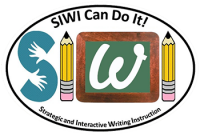Strategic and Interactive Writing Instruction (SIWI): Apprenticing deaf students in the construction of informative text
Tags: apprenticeship, efficacy study, fluency/length, interactive, language delay/deprivation, linguistic/metalinguistic, revision, strategic, word identification, writing, written languageThe purpose of this study was to investigate the effects of writing instruction that was strategic and interactive, namely Strategic and Interactive Writing Instruction (SIWI), when utilized with deaf, middle school students. In addition to strategic and interactive instruction, four minor instructional components included: (a) use of writing examples and non-examples; (b) metalinguistic knowledge building; (c) use of visual scaffolds; and (d) NIP-it lessons (i.e., contextualized mini-lessons involving Noticing, Instructing, and Practicing). The study used a non-equivalent, pretest-posttest control group design to explore whether students receiving SIWI made significantly greater gains compared to those not receiving SIWI on a number of writing variables and reading. The participants of the study were two teachers of the deaf and their respective middle school students. There were 33 total students, 16 in the treatment group and 17 in the comparison group. Students, teachers and schools were matched according to several pertinent variables. The SIWI intervention lasted a total of 8 weeks, during which the treatment teacher guided the collaborative construction of two informative papers; the comparison group continued with their usual literacy instruction. All students were given a battery of assessments prior to and after the intervention to evaluate any gains. These measures included (a) an informative writing assessment, (b) an editing and revising task, (c) a generalization writing probe similar to a 7th grade state standardized assessment, and (d) a SORT-R reading test. The first three measures were scored, according to rubrics, for organization, coherence, evidence of text structure, contextual language, and conventions. A second rater scored approximately 10 to 20% of the papers and obtained an interrater reliability of 0.93 to 1.0. A multivariate analysis of variance (MANOVA) was performed along with the necessary follow-up univariate analyses. All analyses were statistically significant, finding SIWI to be an effective instructional approach. Furthermore, the effect sizes (d) or the magnitude of the differences between group means for writing variables were large to very large, ranging from 1.27 to 2.65. The effect size for the reading variable was small to moderate at 0.39.
Read in Full